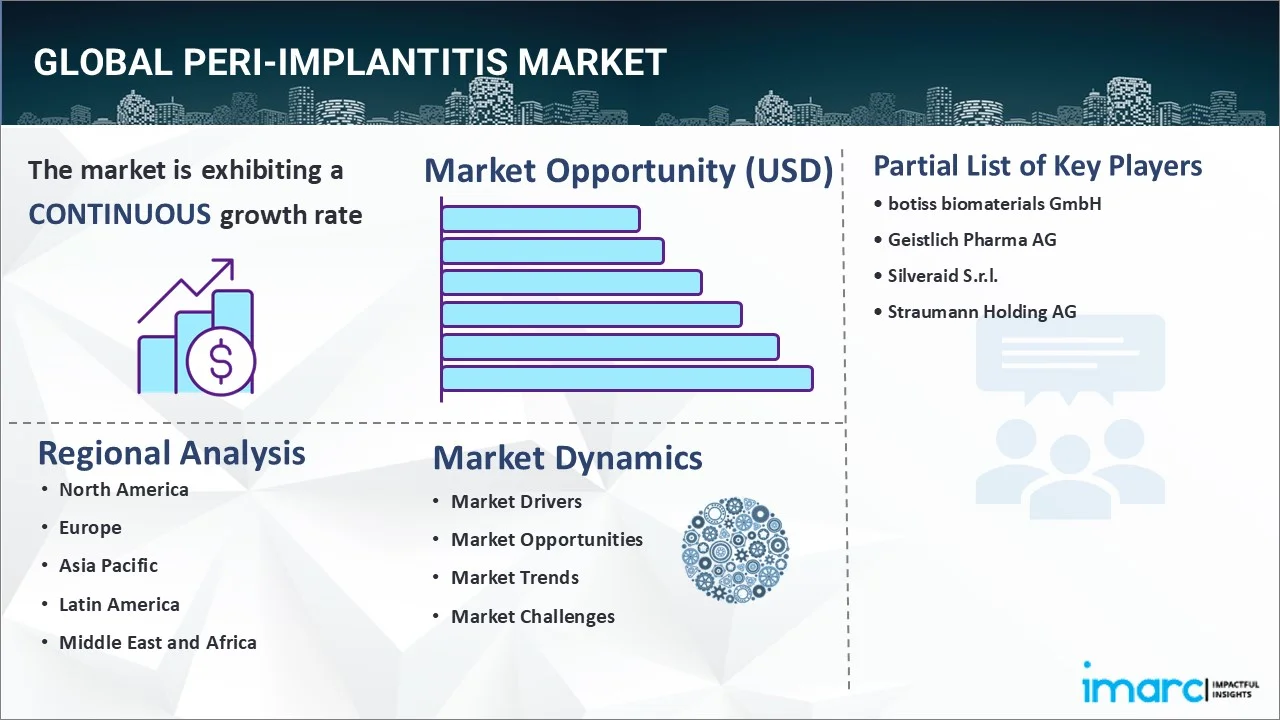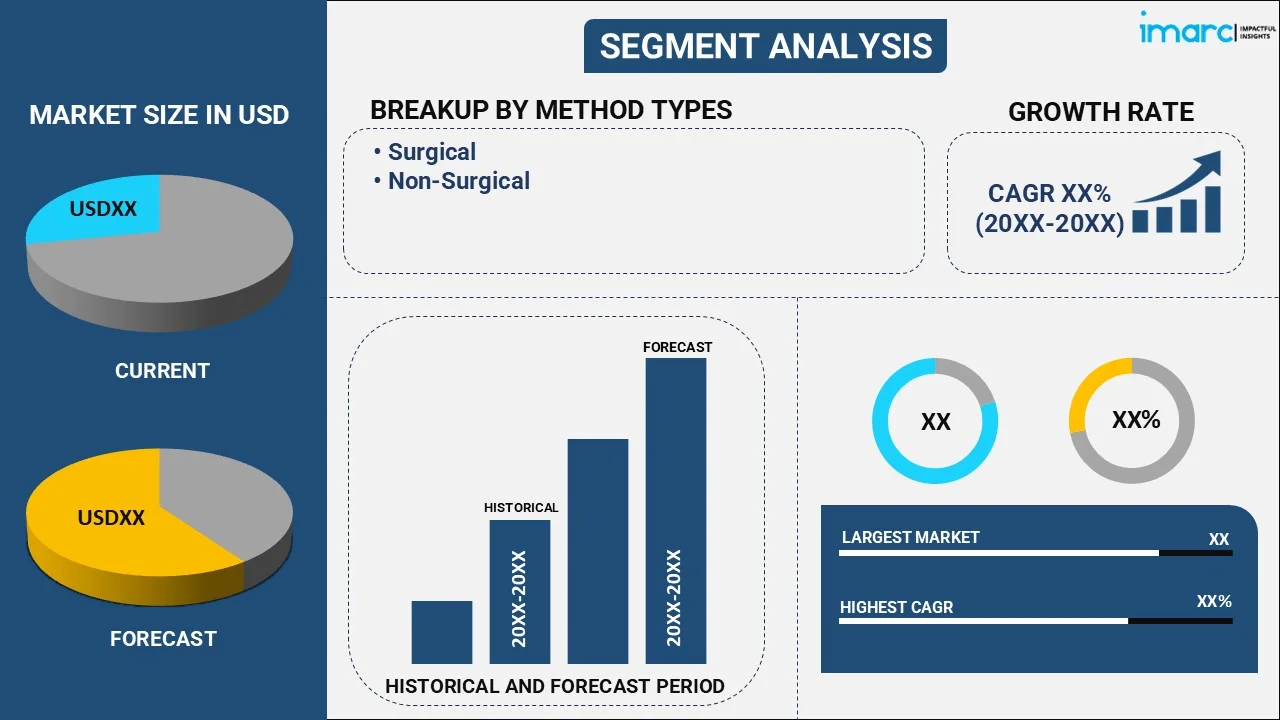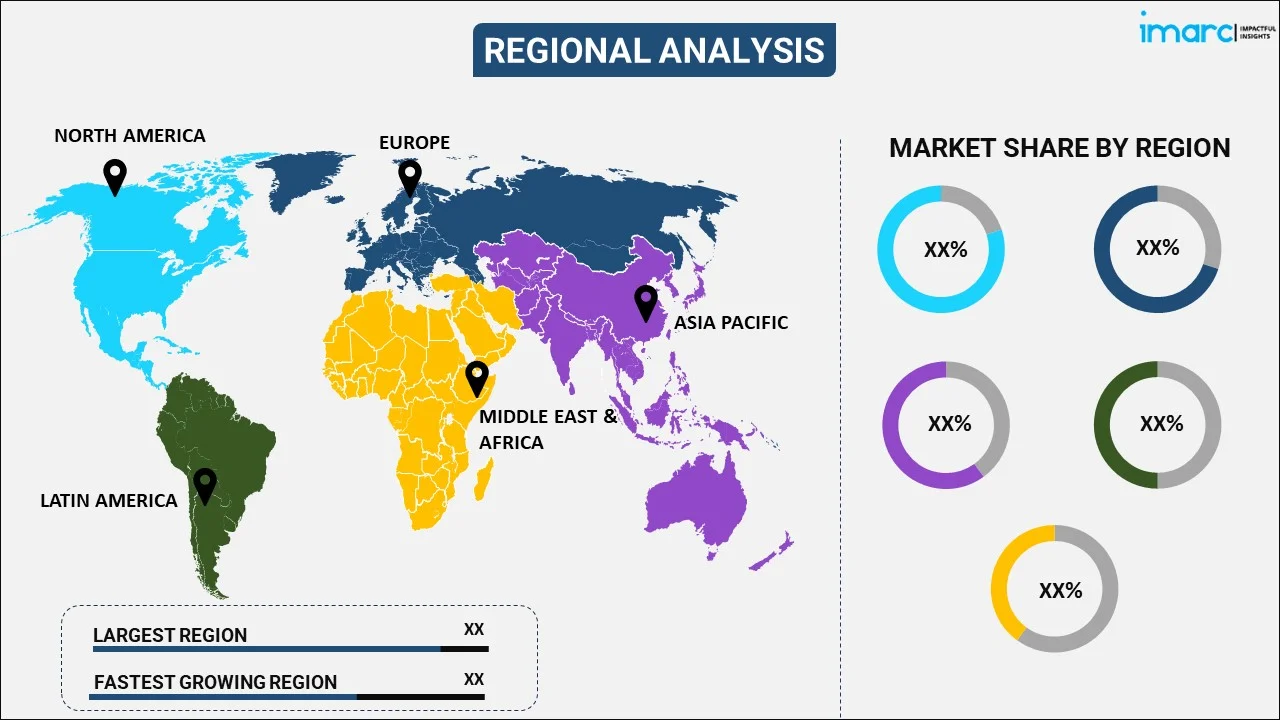
Peri-Implantitis Market Report by Method Type (Surgical, Non-Surgical), End User (Hospitals, Dental Clinics, and Others), and Region 2025-2033
Peri-Implantitis Market Size, Share And Trends:
The global peri-implantitis market size reached USD 1,071.6 Million in 2024. Looking forward, IMARC Group expects the market to reach USD 2,087.3 Million by 2033, exhibiting a growth rate (CAGR) of 7.69% during 2025-2033. The shifting consumer preferences toward aesthetic dental implants, the increasing number of collaborations among dental implant manufacturers, healthcare providers, and research institutions and continual improvements in healthcare infrastructure are some of the major factors propelling the market.
|
Report Attribute
|
Key Statistics
|
|---|---|
|
Base Year
|
2024 |
|
Forecast Years
|
2025-2033
|
|
Historical Years
|
2019-2024
|
| Market Size in 2024 | USD 1,071.6 Million |
| Market Forecast in 2033 | USD 2,087.3 Million |
| Market Growth Rate (2025-2033) | 7.69% |
Peri-implantitis is a condition that affects dental implants, which are artificial tooth roots used to replace missing teeth. It is characterized by inflammation and infection of the tissues surrounding a dental implant. This condition can lead to the loss of bone around the implant, potentially compromising its stability and function. It is caused primarily by the accumulation of plaque and bacteria on the implant surface, peri-implantitis shares similarities with periodontal disease, which affects natural teeth. Common risk factors include poor oral hygiene, smoking, diabetes, and a history of gum disease. Its symptoms may include redness, swelling, bleeding, discomfort, and even pus around the implant site. Left untreated, peri-implantitis can result in bone loss and implant failure.

The global market is majorly driven by the growing awareness among the masses. Apart from this, an aging population has led to a higher demand for dental implants, as older individuals seek improved oral function and aesthetics. With age, the risk of peri-implantitis also rises, driving the need for effective solutions and treatments. Moreover, dental implants are favored for their natural appearance and functionality. Patient preferences for aesthetics and improved quality of life drive the demand for dental implants, indirectly influencing the peri-implantitis market. Furthermore, continual improvements in healthcare infrastructure, especially in emerging economies, have made dental implant procedures more accessible. This accessibility drives market growth by increasing the number of potential patients across the globe. Additionally, the increasing number of collaborations among dental implant manufacturers, healthcare providers, and research institutions fosters the exchange of knowledge and expertise. These partnerships accelerate the development of innovative products and treatment approaches for peri-implantitis.
Peri-Implantitis Market Trends/Drivers:
Continual Technological Advancements
Technological advancements in the field of dental implants have significantly transformed the landscape of the peri-implantitis market. These advancements encompass innovations in implant design, materials, and surface coatings, all of which play a pivotal role in reducing the risk of peri-implantitis and enhancing overall treatment outcomes. This progress has garnered attention from both patients and dental practitioners, thereby fueling growth within the peri-implantitis market. The use of advanced biocompatible materials, such as titanium alloys and zirconia, has revolutionized the durability and compatibility of dental implants. These materials are not only well-tolerated by the body but also exhibit properties that resist bacterial adherence, a crucial factor in preventing peri-implantitis. The integration of these materials in implant construction contributes to a lowered risk of infection and inflammation. Some coatings incorporate antibacterial properties, which inhibit the growth of harmful bacteria around the implant site, which is a pivotal step in mitigating the risk of peri-implantitis.
Increasing Prevalence Among the Masses
The increasing prevalence of dental implant procedures worldwide is a significant factor driving the growth of the peri-implantitis market. This trend reflects the growing popularity of dental implants as a solution for replacing missing teeth and restoring oral function and aesthetics. Compared to traditional alternatives, such as dentures and bridges, implants offer superior stability, durability, and a more natural appearance. This increased acceptance and demand for dental implants contribute directly to the escalating prevalence of implant procedures. Modern lifestyles emphasize aesthetics and functionality. Individuals are increasingly seeking dental solutions that not only address the functional aspects of chewing and speaking but also provide a natural-looking smile. Dental implants align with these expectations, further boosting their demand and contributing to the prevalence of implant procedures. Growing awareness about dental health and available treatment options has encouraged more individuals to consider dental implants as a viable choice. Patients are better informed about the benefits of implants and their potential to enhance overall oral well-being.
Growing Dental Tourism
Dental tourism allows individuals to access quality dental care at a fraction of the cost they might incur in their home country. This cost advantage is particularly appealing for complex procedures, including dental implants. Its destinations often offer access to skilled dental professionals with expertise in various dental treatments, including implantology. Patients can benefit from the knowledge and experience of specialists who are trained in providing effective implant procedures. Dental tourism provides individuals with the opportunity to combine dental treatment with a unique cultural experience. Patients can explore new destinations while receiving dental care, making the process more enjoyable and memorable. Dental professionals and clinics participating in dental tourism networks can leverage a broader patient base. This encourages competition, leading to improved services and offerings, including preventative measures against conditions, including peri-implantitis.
Peri-Implantitis Industry Segmentation:
IMARC Group provides an analysis of the key trends in each segment of the global peri-implantitis market report, along with forecasts at the global, regional and country levels from 2025-2033. Our report has categorized the market based on method type and end user.
Breakup by Method Type:

- Surgical
- Bone Regeneration
- Open Flap Debridement
- Implantoplasty
- Non-Surgical
- Mechanical Debridement
- Laser Debridement
- Antibiotics
- Others
Surgical dominates the market
The report has provided a detailed breakup and analysis of the market based on the method type. This includes surgical (bone regeneration, open flap debridement and implantoplasty) and non-surgical (mechanical debridement, laser debridement, antibiotics and others). According to the report, surgical represented the largest segment.
Surgical methods offer a precise and targeted approach to addressing peri-implantitis. Techniques such as flap surgery or laser-assisted therapy allow dental professionals to directly access the infected or inflamed areas around the implant. This precision is crucial in effectively removing bacteria and infected tissues, promoting healing, and preventing further progression of the condition. Surgical procedures allow for thorough debridement and decontamination of the implant site. Dental practitioners can meticulously clean the implant surface, remove plaque and calculus buildup, and eliminate bacterial biofilm that contributes to peri-implantitis.
On the other hand, non-surgical methods are often more cost-effective than surgical interventions. They can be performed during routine dental visits and do not require specialized equipment or extensive post-operative care. This method emphasizes patient education and proper oral hygiene practices. Patients are empowered to maintain good oral health, reducing the risk of peri-implantitis and the need for more invasive treatments. It does not require incisions or sutures, making them less disruptive to the implant site and the surrounding tissues. This non-disruptive nature contributes to a quicker healing process.
Breakup by End User:
- Hospitals
- Dental Clinics
- Others
Hospitals dominates the market
The report has provided a detailed breakup and analysis of the market based on the end user. This includes hospitals, dental clinics and others. According to the report, hospitals represented the largest segment.
Hospitals often have access to a diverse team of healthcare professionals, including oral surgeons, periodontists, prosthodontists, and implantologists. This multidisciplinary approach ensures that patients receive well-rounded and collaborative care for managing peri-implantitis. They are equipped with state-of-the-art diagnostic technologies, such as digital imaging, cone-beam computed tomography (CBCT), and 3D scanning. These tools enable accurate assessment of peri-implant conditions, aiding in precise diagnosis and treatment planning.
On the contrary, dental clinics are widespread and easily accessible, making them the primary point of contact for individuals seeking dental care, including peri-implantitis management. Their convenient locations and availability ensure that patients can receive timely treatment and follow-up care. Dental clinics are staffed by skilled and experienced dental professionals, including general dentists, periodontists, and implantologists. These experts are well-versed in diagnosing and treating peri-implantitis, ensuring comprehensive care for patients.
Breakup by Region:

- North America
- United States
- Canada
- Europe
- Germany
- France
- United Kingdom
- Italy
- Spain
- Others
- Asia Pacific
- China
- Japan
- India
- South Korea
- Australia
- Indonesia
- Others
- Latin America
- Brazil
- Mexico
- Others
- Middle East and Africa
Europe exhibits a clear dominance, accounting for the largest peri-implantitis market share
The report has also provided a comprehensive analysis of all the major regional markets, which include North America (the United States and Canada), Europe (Germany, France, the United Kingdom, Italy, Spain, and others), Asia Pacific (China, Japan, India, South Korea, Australia, Indonesia, and others), Latin America (Brazil, Mexico, and others), and the Middle East and Africa. According to the report, Europe accounted for the largest market share.
Europe boasts a robust healthcare infrastructure, including modern medical facilities, well-equipped dental clinics, and specialized dental departments within hospitals. This infrastructure supports comprehensive peri-implantitis management and ensures patients have access to a wide range of treatment options. The region is at the forefront of technological innovation in dentistry. Europe’s dental professionals have access to cutting-edge diagnostic tools, imaging techniques, and treatment modalities that enable precise diagnosis and effective management of peri-implantitis. Europe is home to renowned research institutions and dental schools that conduct pioneering research in implantology and peri-implantitis. This research drives advancements in treatment approaches, prevention strategies, and patient care protocols. The presence of highly skilled and specialized dental professionals, including implantologists, periodontists, and oral surgeons, contributes to Europe’s dominance. These experts offer a wealth of knowledge and experience in managing peri-implantitis cases.
Competitive Landscape:
Key players recognize the importance of research and education in addressing peri-implantitis. They invest in studying the causes, risk factors, and effective treatment methods to develop evidence-based protocols that guide dental professionals in preventing and managing this condition. Apart from this, they emphasize the importance of patient education and oral hygiene maintenance to prevent peri-implantitis from occurring in the first place. They collaborate with dental professionals to create preventive strategies and protocols. Moreover, they play a crucial role in shaping treatment protocols for peri-implantitis. They collaborate with dental practitioners to develop standardized and effective treatment approaches that combine surgical, nonsurgical, and regenerative methods to address various stages of the condition. Peri-implantitis treatment often requires a multidisciplinary approach involving periodontists, oral surgeons, prosthodontists, and dental hygienists. Key players promote collaboration among these specialists to ensure comprehensive patient care.
The report has provided a comprehensive analysis of the competitive landscape in the market. Detailed profiles of all major companies have also been provided. Some of the key players in the market include:
- botiss biomaterials GmbH
- Geistlich Pharma AG
- Silveraid S.r.l.
- Straumann Holding AG
Peri-Implantitis Market Report Scope:
| Report Features | Details |
|---|---|
| Base Year of the Analysis | 2024 |
| Historical Period | 2019-2024 |
| Forecast Period | 2025-2033 |
| Units | Million USD |
| Scope of the Report | Exploration of Historical and Forecast Trends, Industry Catalysts and Challenges, Segment-Wise Historical and Predictive Market Assessment:
|
| Method Types Covered |
|
| End Users Covered | Hospitals, Dental Clinics, Others |
| Regions Covered | North America, Europe, Asia Pacific, Latin America, Middle East and Africa |
| Countries Covered | United States, Canada, Germany, France, United Kingdom, Italy, Spain, China, Japan, India, South Korea, Australia, Indonesia, Brazil, Mexico |
| Companies Covered | botiss biomaterials GmbH, Geistlich Pharma AG, Silveraid S.r.l., Straumann Holding AG, etc |
| Customization Scope | 10% Free Customization |
| Post-Sale Analyst Support | 10-12 Weeks |
| Delivery Format | PDF and Excel through Email (We can also provide the editable version of the report in PPT/Word format on special request) |
Key Questions Answered in This Report:
- How has the global peri-implantitis market performed so far, and how will it perform in the coming years?
- What are the drivers, restraints, and opportunities in the global peri-implantitis market?
- What is the impact of each driver, restraint, and opportunity on the global peri-implantitis market?
- What are the key regional markets?
- Which countries represent the most attractive peri-implantitis market?
- What is the breakup of the market based on the method type?
- Which is the most attractive method type in the peri-implantitis market?
- What is the breakup of the market based on the end user?
- Which is the most attractive end user in the peri-implantitis market?
- What is the competitive structure of the global peri-implantitis market?
- Who are the key players/companies in the global peri-implantitis market?
Key Benefits for Stakeholders:
- IMARC’s report offers a comprehensive quantitative analysis of various market segments, historical and current market trends, market forecasts, and dynamics of the peri-implantitis market from 2019-2033.
- The research study provides the latest information on the market drivers, challenges, and opportunities in the global peri-implantitis market.
- The study maps the leading, as well as the fastest-growing, regional markets. It further enables stakeholders to identify the key country-level markets within each region.
- Porter's five forces analysis assist stakeholders in assessing the impact of new entrants, competitive rivalry, supplier power, buyer power, and the threat of substitution. It helps stakeholders to analyze the level of competition within the peri-implantitis industry and its attractiveness.
- Competitive landscape allows stakeholders to understand their competitive environment and provides an insight into the current positions of key players in the market.
Need more help?
- Speak to our experienced analysts for insights on the current market scenarios.
- Include additional segments and countries to customize the report as per your requirement.
- Gain an unparalleled competitive advantage in your domain by understanding how to utilize the report and positively impacting your operations and revenue.
- For further assistance, please connect with our analysts.
 Request Customization
Request Customization
 Speak to an Analyst
Speak to an Analyst
 Request Brochure
Request Brochure
 Inquire Before Buying
Inquire Before Buying




.webp)




.webp)












